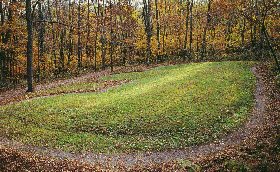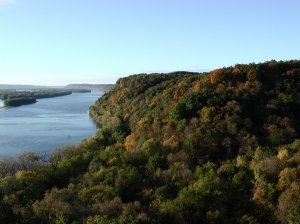The Persistence of Memory
by Brian Peters
Have you seen Jack-In-The-Green?
With his long tail hanging down.
He quietly sits under every tree --
in the folds of his velvet gown.
He drinks from the empty acorn cup
the dew that dawn sweetly bestows.
And taps his cane upon the ground --
signals the snowdrops it's time to grow.
--Ian Anderson, "Jack-In-The-Green"
from the Jethro Tull Album
Songs from the Wood
 I went for a walk in the woods today. They were sacred woods, I suppose, or at least woods with sacred green monuments, wandering along the Mississippi River. The National Park Service calls it Effigy Mounds National Monument, and they've worked hard to keep it a place of memory; in this case a memory of the lives of Woodland Indians, many centuries ago. I wondered, as I walked, about the persistence of memory. It's the primary monument most of us leave behind -- those effects that we've had, for good or ill, on the lives of family and friends. Sooner or later those memories must become a distant background in the fabric of future lives, much the way these mounds have become a part of the landscape along the river bluffs.
I went for a walk in the woods today. They were sacred woods, I suppose, or at least woods with sacred green monuments, wandering along the Mississippi River. The National Park Service calls it Effigy Mounds National Monument, and they've worked hard to keep it a place of memory; in this case a memory of the lives of Woodland Indians, many centuries ago. I wondered, as I walked, about the persistence of memory. It's the primary monument most of us leave behind -- those effects that we've had, for good or ill, on the lives of family and friends. Sooner or later those memories must become a distant background in the fabric of future lives, much the way these mounds have become a part of the landscape along the river bluffs.
That brought me, as I listened to my heart pounding on my way up the path to a steep limestone bluff, to a favorite memory of a man I'll call "Cane." You didn't know him, most likely, and that's a pity; the world has too few genuine characters left. He was an Irish Catholic Democrat, usually in that order, and the closest thing I've ever met to an old country lawyer. He was fiercely devoted to his clients, many of whom he'd known since they'd seen his office from a perch atop their parents or grandparents arms. He was pretty sure the world was out to get the little people, and he rarely passed up a chance to lampoon the government or "those thieving corporations" when they crossed his path. Physically, he wasn't a large person at all, but between a quick mind and a devastating sense of timing he could dominate a room in his own, rather sly, way.
 Using quite different tricks, the National Park Service has made the effigy mounds dominate their setting. The mounds were constructed by Woodland Indians, roughly 750 to 1400 years ago. The oldest are simply circular or oblong mounds of earth, but during the "effigy period" they were built in the shapes of what appear to be birds, turtles, lizards, bison, and most commonly, bears. The people who left these monuments to the memory of honored dead left us little else in the way of records -- certainly nothing written, and really no traceable oral tradition -- to indicate why they constructed the mounds as they did, or why the tradition was abandoned.
Using quite different tricks, the National Park Service has made the effigy mounds dominate their setting. The mounds were constructed by Woodland Indians, roughly 750 to 1400 years ago. The oldest are simply circular or oblong mounds of earth, but during the "effigy period" they were built in the shapes of what appear to be birds, turtles, lizards, bison, and most commonly, bears. The people who left these monuments to the memory of honored dead left us little else in the way of records -- certainly nothing written, and really no traceable oral tradition -- to indicate why they constructed the mounds as they did, or why the tradition was abandoned.
The Park Service has limited all access to the mounds to walking trails, and quite cleverly set the trails so that the initial approach on all is an extended, steeply rising walk up a bluff. By the time you first reach the mounds, you're so grateful to be walking on relatively even ground that you're convinced of the dreadful importance of what you're seeing. At the same time, the trails carry you a long way from the roads and traffic noises into a kind of forest stillness where your steps almost seem to echo -- and that's quite an effect.
The mounds are simply a part of the landscape -- distinguished mainly by the Park Service carefully trimming the grass and plants around them to set them off. The mounds have an earthy mystery about them that has a stilling effect. Always the question of what the builders hoped would be remembered lingers over them.
Which left my mind to wander to my favorite memory of Cane, seemingly coming unbidden in that green hall of memory. It was in the back dining room of a local restaurant. He had come in for lunch, when, from a far table was heard, "Say, would you like to pay for my lunch?" Now the person asking, and probably everyone in the room, knew the answer to that question. That was asking Jack Benny, "Your money or your life?" without any credible threat. But sometimes it's fun to quiz the oracle to see how the question is answered, and that must have been the thought. Still, the oddest thing happened. He said, "Well..." and then paused, and his hand slowly moved toward his back pocket. And for that brief pause, everything in the room stopped. Waitresses slowed and turned, diners stopped forks halfway to their mouths, staring at his hand moving closer to his wallet. The known laws of nature hung in the balance, and somewhere in that forever pause I think the Mississippi River itself slowed in its channel, thinking that, perhaps, it should flow north and up-channel for a change. Then Cane folded his arms and said, "Well, no." And the stars remained in their courses, and the river resumed its resolutely southern journey, and the whole room broke into laughter, as much from relief that gravity would still hold and the earth remained in its orbit as anything. At least that's how I remember it.
 I was thinking about that as I passed the last set of those quiet, grassy mounds on the way to hanging rock, the trail's end and the northernmost point in the park. It's a good three and a half miles one way from the visitors center, and the Park Service goes out of their way to discourage out-of-shape visitors, like me, from going that far on the trail. What they don't say, though, is that it's worth every step up and down three or four bluffs to get the most stunning view for miles up and down the river. I left, ecstatic from the view, and happy from the memory, and as I trudged back past the mounds, I was sure I could hear chuckles from the long grass, at the memory of the day the river nearly flowed north.
I was thinking about that as I passed the last set of those quiet, grassy mounds on the way to hanging rock, the trail's end and the northernmost point in the park. It's a good three and a half miles one way from the visitors center, and the Park Service goes out of their way to discourage out-of-shape visitors, like me, from going that far on the trail. What they don't say, though, is that it's worth every step up and down three or four bluffs to get the most stunning view for miles up and down the river. I left, ecstatic from the view, and happy from the memory, and as I trudged back past the mounds, I was sure I could hear chuckles from the long grass, at the memory of the day the river nearly flowed north.
©2001 by Brian Peters



